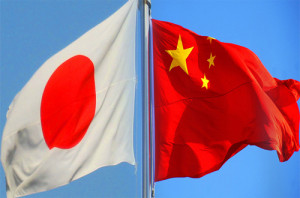
The first is ensuring access to the energy resources in the Persian Gulf as well as their safe passage to Japanese ports. The second, not officially disclosed but fairly evident, stems from perceiving China’s transformation into a global power as the main threat to Japan’s national interests and security.
Because China “reciprocates” in its own evaluation of the process of Japanese “normalisation”, the behaviour of both of these leading Asian countries on the global political area towards each other looks increasingly more like a “marking” strategy of two opposing football players during a game
This strategy put in play by both “teams” is beginning to unfold in all global regions, but it is especially apparent in the space surrounding the abovementioned sea route stretching through the Indian Ocean, Strait of Malacca, the South China Sea and ending at the ports in China, Taiwan, South Korea and Japan.
From the time when he came to power at the end of 2012, current Japanese Prime Minister Shinzo Abe’s attention has been focused on increasing Japanese presence in the South China Sea and the Strait of Malacca. The PM and his key ministers paid the most visits to countries in Southeastern Asia which surround the strait.
It is important to note that during these visits and negotiations with his counterparts in these countries, together with using Japan’s traditional economically-minded foreign policy tool, the military and technical aspect of the country’s cooperation is becoming increasingly more important. This is greatly encouraged in Southeast Asian countries for fairly obvious reasons.
It should be noted that the signs indicating Japan’s renewed interest in the Indian Ocean region, clearly evident during both world wars, already manifested during Shinzo Abe’s first term in 2006 to 2007. During his Indian visit in 2007, he formulated the concept of the “arc of instability”. As was noted by analysts then, “in an odd coincidence”, the arc coincided with the abovementioned sea route vital for Japan.
In the summer of 2011, Japan opened its first post-war foreign military base after renting land in Djibouti, namely the western tip of the critically important sea route, in order to fight the “Somali pirates”, which would have been made up if they didn’t exist.
Incidentally, to supress the same “pirate threat”, China also signed an agreement with Djibouti to build its own military base at the beginning of 2013. And yet, warships and military planes from all leading regional players have long been patrolling the entry into the Persian Gulf.
The evidence of Japan’s newly active political phase in the Indian Ocean region came in the form of negotiations between Shinzo Abe and the new Indian PM Narendra Modi during the latter’s five-day visit to Japan held at the beginning of September and the subsequent Asian tour of the Japanese PM himself with stops in Bangladesh and Sri Lanka.
However, the beginning of a new phase of renewed Japanese interests in the Indian Ocean may have started in May 2013 when, during another tour across Southeast Asian countries, the Japanese PM also stopped at Myanmar (former Burma). As a matter of fact, Myanmar geographically links the Indian Ocean and Southeast Asian regions. This is why the fight to gain control over its territory is quickly gaining momentum as part of the game unfolding between the leading players in the space surrounding the Indian Ocean and Pacific Ocean basins.
As for Modi’s trip to Japan, right away analysts noticed the fact that this was the first country he toured in a long list of foreign visits. The main reason for this was far from Modi’s respect towards Japan and personally to its current PM. Although the photographs taken by news agencies during the bilateral meetings showcase the presence of these feelings better than any words could.
The new Indian PM continues on the road to closer political ties with Japan that was laid down by his predecessors. Although the volume of Indian trade with China is an order of magnitude larger than with Japan, China is increasingly seen as a geopolitical opponent whereas Japan is viewed as the main potential political ally for India.
Due to this, there seems to have been a noticeable “jealousy” with which China viewed Modi’s trip to Japan. Comments from the Chinese press may be summarised as “it’s better for India to be friends with us (China)” (see Modi knows China relations more important in long run by Liu Zongyi, Global Times).
The same “Chinese topic” was also present in the comments that followed Abe’s visits to Bangladesh and Sri Lanka. They ignited talks about the proverbial “string of pearls” strategy that is supposedly being followed by China in Southeast Asia overall and in India in particular.
There are also assumptions that Japan intends to create its own “string of pearls” in Southeast Asia, a network of military bases along the entire space from Djibouti to the Strait of Malacca. However, these speculations are currently just that and presently we can only wait and see how the game between the leading regional nations unfolds.
Upcoming events which deserve special attention will be the visit of the Chinese President Xi Jinping to India and Modi’s subsequent trip to another UN General Assembly session, where he plans to meet with US President Barack Obama.
The second event becomes especially interesting because up until the end of last year, when Modi’s Bharatiya Janata Party was assured victory in the upcoming parliamentary elections, he had for several years been banned from the US. However, now Modi is practically the most anticipated guest for the American administration, and it’s fairly evident why.
Vladimir Terekhov, leading research fellow at the Centre for Asian and Middle Eastern Studies at the Russian Institute of Strategic Research, exclusively for the online magazine “New Eastern Outlook”.
